The efficacy and function of three-leaf copper coin grass

|
Three-leaf pennywort is a very common Chinese medicine in our daily life and is also very important in our daily life. However, some people don’t know much about the efficacy and functions of three-leaf pennywort, so let us learn about it in detail below. [Alias] Oxalis. [Source] Medicinal material source: the whole herb of Oxalis alba, a plant of the Oxalidaceae family. [Original form] Oxalis alba is a perennial herb. Stem shortened, sparsely hairy. The rhizome is creeping, thin, with light brown scales and a series of spindle-shaped bulblets, and slender lateral roots. Leaves are basal; petiole is about 5-7cm long and nearly glabrous; leaflets are 3, obcordate, 1-2cm wide, green above and gray-green below. The pedicel is slender and sparsely hairy, with one flower that hangs down or leans to one side, and a pair of bracts on the upper part; the flowers are white or with purple veins; the sepals are membranous, oblong, 2.5 cm long, and persistent in fruit; the petals are obovate-oblong, 7-81 nm long, concave at the apex, and membranous; there are 10 stamens, which are shorter than the petals, and the filaments are slender and fused at the base. The capsule is spherical, slightly pointed at the tip, 3-4 mm long, 5-valved, with 1-2 seeds in each chamber. The seeds are ovate, about 2mm long and 1.5mm wide, dark brown, slightly flat, with luster and vertical and horizontal grooves. The flowering period is July-August, and the fruiting period is August-September. [Habitat distribution] Ecological environment: Grown in coniferous forests, mixed coniferous and broad-leaved forests, under mixed woods and in shady and wet land under thickets. [Chemical composition] The above-ground parts contain orientin and 2"-gluco-isovitexin. 【Nature and flavor】 Sour; slightly spicy; neutral 【Meridian】 Heart; Liver; Bladder 【Functions and indications】Promote blood circulation and remove blood stasis; clear away heat and detoxify; promote diuresis and relieve stranguria. Mainly used for pain caused by overwork, injuries from falls, leprosy, swelling, scabies, mouth sores in children, burns, stranguria, leukorrhea, and urinary retention [Usage and Dosage] Oral administration: decoction, 3-10g, large dose can be up to 90g. For external use: take appropriate amount, decoct in water for washing, mash for application; or grind into powder and mix with vegetable oil for application. 【Note】 "Handbook of Commonly Used Chinese Herbal Medicines in Heilongjiang": "Pregnant women should use with caution." 【Excerpt】 Chinese Materia Medica The above content is an introduction to the traditional Chinese medicine Three-Leaf Copper Coin Grass. We should learn more about Three-Leaf Copper Coin Grass in our daily life so that we can use it more reasonably and better realize the value of Three-Leaf Copper Coin Grass. |
<<: The efficacy and function of bitter forsythia
>>: The efficacy and function of dried radish
Recommend
How long does it take to boil Chinese medicine?
When we are undergoing traditional Chinese medici...
Soapberry: I am a relative of longan and longan, and I am also the "cleaning master" in the plant world
Painted by Qi Yunzhi In early spring, tender goos...
What are the uses of loquat kernels?
Loquat is a fruit that everyone may have tasted. ...
On the 413th anniversary of the birth of the telescope, what secrets did Galileo see with it?
August 21, 2022, is the 413th anniversary of the ...
Comparison chart of blackberry and Jiaogulan
The appearance of blackberry and Gynostemma penta...
How to move a 200-ton hotel? Just 700 bars of soap
What tools are needed to move a building? Recentl...
This makeup habit of girls is secretly bringing tens of thousands of bacteria
A study by Aston University in the UK found that ...
What Chinese medicine should I take for gastroptosis?
After eating, taking a walk can not only help dig...
The efficacy and function of Millennium wormwood
Millennium mugwort is a common type of traditiona...
Both friend and foe, what impact do microorganisms have on human health?
Microbes are the kings of the earth Creating habi...
Can wind turbines grow infinitely?
Produced by: Science Popularization China Author:...
Nutritional value of marjoram
Marjoram is a fragrant herb with many uses. It ca...
ChatGPT actually started asking for tips! Is AI still far from "blackmailing" humans?
In the eyes of many people, artificial intelligen...
Relying on yourself for everything is a sign of a person who has been hurt
From childhood to adulthood, I believe many peopl...
Will there be no mosquitoes if you live in a high-rise building? Mosquito: How high can you guess I can fly?
"If you live high enough, there will be no m...

![[Cultivation Program] In the hot summer, insects have a "cool way" to escape the heat](/upload/images/67f0e6897f34a.webp)







